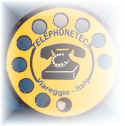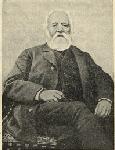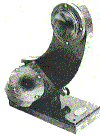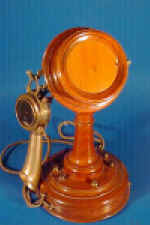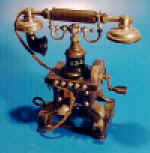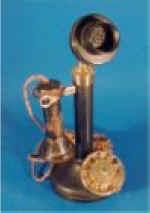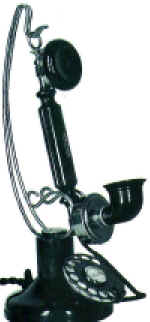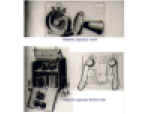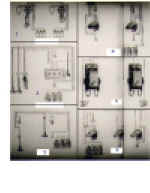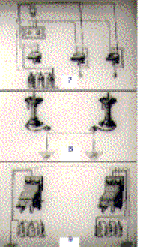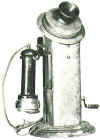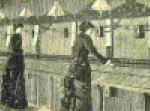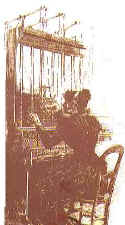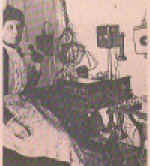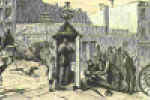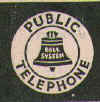Gli USA riabilitano Meucci
Il Congresso degli Stati Uniti ha riconosciuto i meriti di Antonio Meucci (nella foto) quale inventore del telefono. Approvando una mozione presentata da un deputato italo-americano, la Camera USA ha riabilitato dunque l'inventore fiorentino, riconoscendo che Alexander Grahan Bell gli sottrasse la gloria solo perchè aveva i soldi per brevettare l'invenzione.
11 Giugno 2002
USA rehabilitate Meucci
The Congress of the United States has recognized the merits of Anthony Meucci (in the photo) inventor of the telephone. Approving a motion introduced by a deputy italo-American, the Chamber USA has rehabilitated the Florentine inventor, recognizing that Alexander Grahan Bell subtracted to him the glory only because he had money to patent the invention.
June 11th 2002
Alexander
Graham Bell:
what have you started?

Prehistory of the
telephone
The Journal
Télégraphique of 1878 according to the "Gazette de Pékin"
the telephone, or Thumt-sein, was invented in China in the year 968
by a learned man whose name was Kung-Foo-Whing.
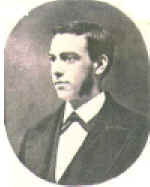
Thomas A. Watson, 1874
But, although it seems generally acknowledged that Bell made the first
authentic demonstration of the transmissione of speech by telephone, there
is still controversy as to who was the first person to design a workable
telephone suitable for the transmission of speech. Already in the 1850s a
number of inventors had proposed the use of the make-and-break principle
of the telegraph for transmitting the pitch of sounds. Among these
inventors were Edward Farrar (United States), Charles Bourseul (France),
Philipp Reis (Germany),
Antonio Meucci (Italy)
and many others.

Antonio Meucci

The first telephone of Anthony Meucci
The Italian Historical Society of America sustains that Antonio Meucci, an
immigrant from Italy who lived in Staten Island in new York City, invented
the telephone, and has been denied fame and fortune only because he lacked
$250 and because Bell himself rifled the files of a patent office,
destroyng the evidence of Meucci's invention. The Society argues that
Meucci filed a patent for a "telefono" on Dec.28,1871, a full
five years before Bell filed his patent. "We can only credit Mr. Bell
with commercializing the invention of Meucci", said John La Corte,
the president of the Italian Historical Society of America. "In the
tradition of fair play and honesty, let Meucci have the honor to be
recognized as the "Father of the Telephone" in the encyclopedia.
Let Mr. Bell have the money." According to the Society, in 1871
Meucci could not afford the $250 necessary to purchase a regular patentfor
his telefono, so he purchased a temporary patent for $10. In 1874, Meucci
still did not have $250 and his temporary patent-number 3335-was aollowed
to lapse.
It was Philipp Reis (1834-1874) who was the first to transmit, in 1861, a
musical melody electrically over a distance. He called his apparatus the
"Telephone".
In the 1870s in the United States two men, unknown to each other, were
working to find ways of transmitting speech electrically. They were
Alexander Graham Bell (1847-1922) and Elisha Gray (1835-1901).
On the same day that Bell filed his patent application, Elisha Gray filed
at the United States Patent Office a caveat (a notice of intent to
perfect his ideas and file a patent application within three months) for
an electric telephone.
It turned out that Bell's patent application had been filed a few hours
earlier than Gray's caveat and the patent was granted to Bell on 7
March 1876.
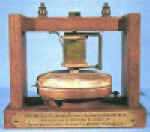
A Bell Company reproduction of Bell's first magneto telephone 1875
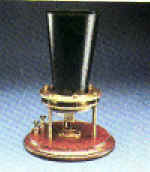
A Bell Company reproduction of Bell's liquid
transmitter. These were used March 10, 1876 when the Bell's voice was
heard by Watson.
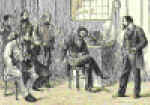

Experiments of the speaking " telegraph " - Boston 1877
Birth of the telephone
business
Bell showed his equipment at
the Philadelphia Centennial Exibition of 1876 which gave it enormous
publicity and Hubbard started marketing it. Watson organised the
manufacture of instruments and Sanders financed the operation. The Bell
Telephone Co. was formed on the 9th July 1877. Sander was appointed as
treasurer, Bell as "electrician" and Watson as "superintendent".
On the 11th July 1877, Bell married Mabel Hubbard. The honeymooners set
sail for England and spent a
year in Britain.
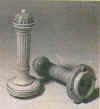 Ivory
handsets prepared for Queen Victoria by Alexander Graham Bell when he
visited England in 1877.
Ivory
handsets prepared for Queen Victoria by Alexander Graham Bell when he
visited England in 1877.
The telephone business was
started jn Britain during this visit with the sale of rights to Bell's
British patent. A "Butterstamp" telephone, 1877, belonged to
Queen Victoria at Osborne House.
While Bell was in Britain, the telephone business was developing fast in
the USA. By January 1878 over 3.000 telephones had been installed and the
first public exchange had opened at New Haven, Conn. with 21 subscribers.
Theodor N. Vail became General Manager of the Bell Telephone System in
1878. It was recognized that telephone performance was a matter of mutual
concern to users and the practice was established of leasing telephones
instead of selling them. Vail understood and he sought to create a
telephone system nationwide and worldwide. The first subscriber in the world was such Charles Gaspare Ghidden of
Lowel.
The first telephone message was transmitted on the 10th March 1876, and,
by 1880, a United States census showed that there were 148 telephone
systems, 48 414 subscribers and 54 319 telephones in existence. The Bell
Telephone Advertisement of 1878
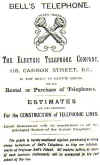
The first telephone exchange opened in Denver. This was 1879, and the
company charge $4 for residential rates and $5 for business phones.
Telephone sets
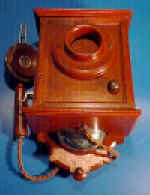
Original telephone manufactured in
Germany/Berlin
around in the year 1878. The big receiver with the part that leans to the
ear in wood brings the writing Tel Fabr AG Berliner . The box in wood brings
the writing. C.F.Lewert—Berlin N°. 287 To notice that the transmitter is constituted by the big
membrane in wood that acts on three coal cylinders. The transmitter to coal
in granular had not been yet invented. A trasmitter in wich granular carbon
was used for the variable contact was invented in 1878 by Henry Hunnings,
and English clergyman. Edison invented a transmitter whose carbon granules
were obtained from anthracite coal and Anthony C. White in 1890 invented
the solid back transmitter using a "button" of granular carbon
placed between a fixed electrode and a diaphragm-actuated movable one. The frontal button served to send the
call. The apparatus is to install to wall. Interesting also the inside where
can be clearly see the three coal cylinders of the transmitter and the
mechanism to send the call.
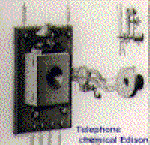 |
 |
 |
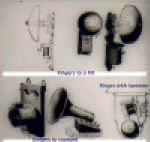 |
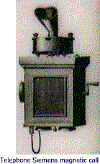 |
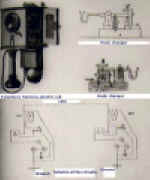 |
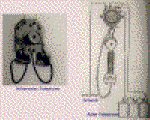 |
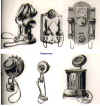 |
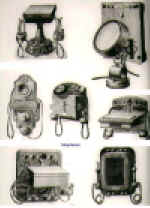 |
 |
 |
 |
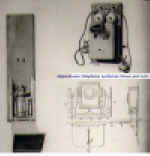 |
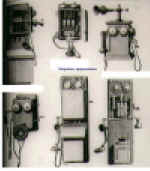 |
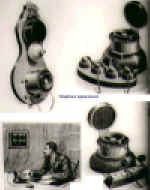 |
 |
The plastic revolution
By the late 1920s, plastic had been
introduced, and in 1929 the first completely moulded plastic telephone-
the Siemens Neophone-appeared. This was lighter and less cumbersome tran
phones made predominantly of metal. Unlike the candlestick, which required
two hands, the new phone could be "used with one hand only, in
complete confort, while the other hand is free for writing or any other
purpose". Plastic also led to a revolution in terms of colour. For
the first time, attempts were made to provide phones that fitted into
people's decorationschemes. An early 1930s advertisement offered a choise
of colours - red, jade green, black or ivory. In those days, the plastic
used (which included Bakelite) had different qualities to those of today.
The telephone really caught on during the 30s. For the first time it
became commomplace in business, and as well as in most upper-and
middle-class homes.
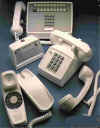 |
 |
Telephone lines
Individual telephone
subscriber, would require to be connected to another subscriber on demand,
and to provide this service, the need for interconnecting them became
apparent. The first telephone circuits employed a single overhead wire
usually of iron with ground return. An important early improvement was the
development by Thomas B. Doolittle in 1877 of hard-drawn copper wire
giving good tensile strengh together with improved electrical conductivity.
The advantages of a two-wire entirely metallic circuit in reducing noise
and interference were soon realized. The first telephone open wire line
was between Boston and New York in 1885. The number of open wire circuits
soon reached the point of saturation and the methods of compacting lines
in overhead or underground cables were tried. The introduction of dry
paper insulation for the conductors completed the foundation for the
modern telephone cable.It was in 1887 that the Englishman Oliver Heaviside
(1850-1925) pointed out that the addition of inductance to telephone
circuits would be beneficial to the transmission of speech. In 1900 the
American professor Michael Pupin (1858-1935) suggested the insertion in
seies of coils having the required inductance and a minimum resistance. By
this methods a substantial reduction in the attenuation of the speech
waves was obtained.
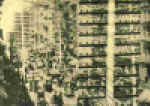 View of Broadway before the telephone urban nets were placed in cable. |
 Telephone cables after a storm of snow |
 A LINE crew in 1890 poses with their wagon loaded with equipment |
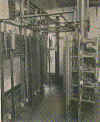 Terminal Room |
| Beginnings of the telephone service | |||
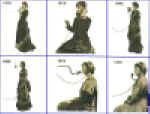 First telephone operators |
 In 1880 telephone equipment was so heavy and cumbersome that operators, who sometimes sat for many long hours, needed a back brace to make it through the day. |
|
|
|
|
 (1915-18)Signal Corps men in ten-foot-deep dugout during the final Meuse-Argonne offensive operate switchboard in touch with front. |
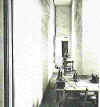 Candlestick telephones installed in the palce of Versailles for use of the delegations to the Peace Conference.(June 1919) |
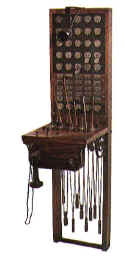 1890 PABX Hasler DC local battery |
 1900 PABX Ericsson-DC local battery |
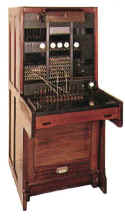 1922 PABX Hasler Universal central battery
|
Caller ID
Call Centers
CTI
ISDN
Generally speaking, telephone
networks are based on analogue processing of an electrical signal generated
by the voice. These networks will change - they will be digitized. The voice
will be converted into a digital signal (based on binary code elements 0 and
1) at each end of a transmission link. The electronic principle of
digitization applies not just to speech but also to data and picture
transmission. The telephone is not the only telecommunications facility that
can be used. Telefax, audio and video conferences, access to data banks, and
television are also available. The situation is going to change by:
- the unification of the various telecommunication
networks;
- the interaction of the various media
A common denominator: the development of the ISDN.
ADSL
Telephone companies around the
world are beginning to recognize the immense value they can still realize
from their copper loop plant.New transmission technologies give them the
capability to construct broadband access networks with existing twisted-pair
wiring. ADSL, an asymmetric modem capable of transmitting high speed data
over copper links, has proved itself in the field and now descends the
learning curve in anticipation of wide scale deployment. ADSL offers rates
from 1.5 Mbps to 8Mbps, sepending on line length, over the very same wires
used for plain old telephone service (POTS). Indeed, ADSL shares the line
with POTS, enabling telephones, fax machines, personal computers, and
televisions to connect to remote services over single line at the same time.
INTERNET-WORLD WIDE WEB
Web traffic must use the local
phone network to reach customers.
HTML, BROWSER, JAVA, WINDOWS, E-MAIL, E-Commerce.
@
IP
The Internet Protocol-based
communications architetture being created by Motorola with Cisco Systems and
others Combining voice with data, multimedia, and the Internet into one
broadband system, accessible through a new generation of access devices.
LIBERALISATION
LEAST COST ROUTING
Routing to the small cost for National long-distance, International and
Mobile calls
MOBILE
GSM/UMTS
The second
generation mobile 2G is created for speech and GSM2G has immense suitability
for voice. People that only want to use voice services or narrowband data
services will use 2G. All the others will move to UMTS3G
UMTS
Universal Mobile Telecommunications
System to meet mobile, data and multimedia needs.
The third generation mobile 3G it is for multimedia applications.
Services that are actually being envisaged: fast wireless access to the
internet, videoconferencing, broadcast, full-motion videophones, video and
audio e-mail, access desktop information, news and media information, access
to libraries and databases, personal diaries, electronic commerce,
interactive shopping, business and share information, education, leisure and
entertainement. In addition, a significant amount of the data traffic that
it is predicted will be carried over UMTS networks is likely to be
machine-to-machine traffic, rather than person-to machine, or
machine-to-person.
The first licenze in March 1999 in Finland, one each to existing mobile
operators, Sonera, Radiolinja and Telia, and one to Suomen Kolmegee, a
consortium comprising 41 regional telcos of the Finnet Group.The UK will be
the next EU country to issue licenses - in March 2000 - followed by
Germanyin May. The Netherlands first half of 2000, while Austria, Italy,
France and Portugal are all expected to licence during the year 2000.
The UMTS Forum's market studies predict that worlwide in the year 2005 there
will be 1bn subscribers for mobile applications and that this will double by
2010.
Satellite technology
(Broadband and Internet service)
Iridium and ICO (GMPCA) global mobile personal communications services.
